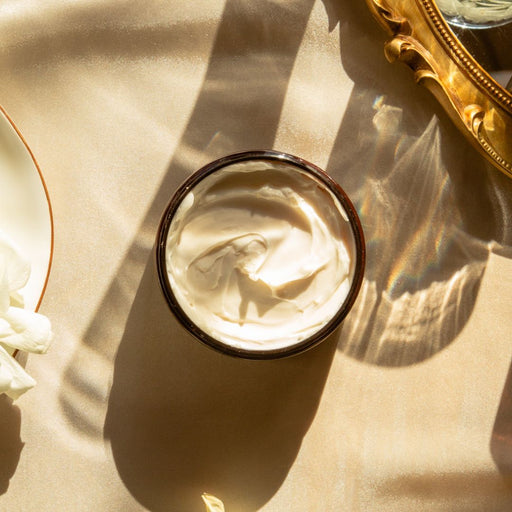
Galangal has long been an essential ingredient in Southeastern Asian cuisines and herbal rituals, effortlessly making its way to the forefront of Thai cooking. This refreshing herb has been used in traditional medicine and ancient healing methods for thousands of years, as it's rich in antioxidants with abundant anti-inflammatory properties.
Key takeaways
-
Galangal is a rhizome that is often used in Southeastern Asia.
-
It belongs to the same family as ginger, though the appearance and flavor vary slightly.
-
Galangal is rich in antioxidants and is known to help protect against certain cancers, fight infections, and reduce inflammation and pain.
-
It is common to use galangal as a paste or to infuse it into broths and soups.
-
Greater galangal is a variety native to Indonesia.
-
The ancient Indonesian wellness custom of jamu has long used galangal in various recipes and herbal remedies.
-
In the book Jamu Lifestyle, you can find ways to effortlessly incorporate holistic healing rituals into your daily life. Plus, it's full of recipes that utilize flavorful and boosting spices and herbs like galangal.
-
Use powdered galangal for curries and baked goods, and be sure to use fresh galangal for soups or similar dishes.
The long-standing Indonesian lifestyle of jamu often utilizes this spicy root in holistic wellness rituals. Whether you want to incorporate galangal into your favorite foods or use it to whip up beras kencur, there are countless ways to benefit from this aromatic herb.
Keep reading, and we'll let you know everything about this jamu ingredient.
See Related: Holistic Diet: What Is It And How Can It Help You?
#1. What is galangal root?
Galangal is a popular herb often used in Thai food and other Southeastern Asian cuisine.
It's a tropical perennial herb, and the underground plant stem is what is used for cooking.
From Indonesia to China, galangal is viewed as an essential ingredient in both cooking and daily life!

A fundamental ingredient in Thai food and other Asian cuisine
Galangal is very similar (though far from identical) to ginger. In fact, it hails from the same family.
Fresh galangal root is one of the most important ingredients in Thai cooking, as it helps create that well-known complex palette of sweet and spicy flavors.
The part of the plant that is used in food is known as the rhizome.
Rhizomes are essentially fleshy, underground stems but can often be mistaken for roots. Ginger, bamboo, and bearded iris are other examples of rhizomes.
#2. What's the difference between galangal and ginger?
Ginger and galangal are both rhizomes and are quite similar herbs.
However, they do have some key differences that shouldn't be overlooked.
Though they have a similar shape and size, galangal root is considerably more smooth and paler than ginger. And, unlike ginger, galangal doesn't need to be peeled before use.
You can safely substitute ginger for galangal
Ginger is occasionally used as a substitute for galangal, but they have varying flavors. Ginger airs on the hot and spicy side, while galangal is more cooling and refreshing.
Though swapping galangal for ginger or vice versa won't ruin your dish, you might be able to pick up on the slight difference in flavor.
But it's fine to do if you happen to find yourself fresh out of galangal!
Bonus: 4 Amazing Benefits Of Maracuja (Passionfruit) Oil
#3. The health benefits of galangal
Galangal isn't just an exceptionally flavorful and aromatic spice.
It's been used throughout history in various medicinal remedies thanks to its powerful health benefits.
The source of galangal's healing properties lies in its vast abundance of antioxidants.
Antioxidants are essential in helping your body's immune system fight against disease and in protecting your cells from free radicals.

Galangal is a powerful wellness remedy that has been used in healthy diets for thousands of years
There have been various studies done on the effects of galangal on human health.
For example, test-tube studies have suggested that the galangin in galangal may be able to kill cancer cells or otherwise prevent their spread.
Other research has shown that galangal may help in fighting inflammation and pain and even in protecting your body against infections.
The essential oils that can be extracted from galangal root are able to combat various microorganisms, which means that galangal can be used to prolong the shelf life of some types of food.
#4. How to cook with galangal root
The primary use of galangal is in cooking. From ancient Southern China to the modern-day Western world, this spice has been used extensively in anything from stir fry to soups.
From infusion to pastes, there's no shortage of ways to use this root
Galangal can be used in various ways. A common method is infusion.
To infuse a simmering broth or soup with galangal, thinly slice the root and then add it to your dish for a few minutes. Be sure to discard it before serving, as it can be tough to eat.
If you're planning on whipping up some Thai food, your recipe will likely call on you to pound galangal into a paste.

Understanding the varieties of galangal
Galangal is a simplistic yet flavorful root that has different varieties.
Though you'll likely only be faced with one type at your local Asian market when you go to buy galangal, there are different types of these aromatic rhizomes that fall under the name galangal.
Lesser galangal is native to Southern China and is often used in Indian and Chinese herbal remedies.
On the other hand, greater galangal is native to the archipelago of Indonesia and has long been used to add a peppery taste to soups and curries.
Fresh galangal is a powerful ingredient in the jamu lifestyle
Galangal is a well-known ingredient in Indonesia and has been used for thousands of years to add robust spice to everyday life. The ancient wellness tradition of jamu often incorporates this ginger relative in anything from healing skincare rituals to flavorful soups.
Jamu is a long-standing and heartfully complex lifestyle that focuses on holistic healing and overall wellness. Whether you want to be more mindful of your diet or embrace your natural beauty, this approach to complete living is a great way to elevate your life.
An ancient tradition passed down for countless generations
The traditions of jamu focus on utilizing plants, spices, herbs, and roots in order to promote holistic wellness and health. This natural approach to life has long benefited people around the globe as the teachings spread from the islands of Indonesia.
In Jamu Lifestyle: Indonesian Herbal Wellness Tradition, the co-founder of JUARA Skincare, Metta Murdaya, illustrates the vast and colorful history as well as the applications of jamu.
From personal stories of families and businesses in modern-day Indonesia to flavorful and health-boosting recipes, this book contains everything you need to know about jamu, galangal, and more complete living.
A classic yet flavorful family recipe
In this book, Metta shares her family recipe for Balinese yellow rice (nasi kuning), which is full of fluffy rice and heartwarming flavors.
In addition to galangal, this delicious meal also contains ground turmeric, a health-boosting spice that adds immense taste.

A strength-maintaining jamu filled with nutritional flavors
Though galangal is used frequently in curry and savory dishes, it can also be incorporated into stimulating and healthy tonics.
Beras kencur is a pure, simple, yet potent drink that provides immense nutrition and strength while maintaining a flavorful and attractive taste.
For this recipe, you begin by sautéing uncooked rice before soaking it. Blend galangal and kedawung with mineral water before straining them with a cloth. Lastly, add some palm sugar or honey for a bit of sweetness.
You can either use a few tablespoons of powdered galangal, or you can use fresh galangal.
#5. Powdered galangal versus whole galangal root
When it comes down to it, there's no exact substitute for galangal. Though you can use ginger in a pinch, it's also important to ensure you use the right form of this herb.
If you don't have fresh galangal on hand, you can also make do with frozen galangal or powdered galangal.
What's important to note here is that you shouldn't use powdered galangal in recipes like soups, as it can contribute to a muddy texture that might disturb your classic dish.
Instead, only use powdered galangal if you're making things like curries or baked goods.
Wrapping up
Whether you want to add some vibrant flavor to your favorite recipes, find a new way to cook with classic Thai ingredients, or infuse your life with some extra spicy health benefits, understanding what galangal is is one way to truly accomplish that and more!
Keep Reading: 4 Ways To Transition Your Skincare Routine From Summer To Winter
--
Juara Skincare incorporates ancient rituals with Western skincare science, creating the ultimate beauty experience. We aim to transport you from the mundane to the extraordinary with our exotic ingredients, intoxicating scents, and powerful, skin-improving formulas. All of our products are nutrient-rich and botanically based. We are proud to be certified cruelty-free. Get the latest skin care tips and info on Juara products by following us on Twitter, Facebook, Instagram, LinkedIn, and Pinterest.














